Stay connected
Subscribe to our Inside WEX blog and follow us on social media for the insider view on everything WEX, from payments innovation to what it means to be a WEXer.

For many of the thousands of companies who sent their workforce home at the start of the COVID-19 pandemic, the move was chaotic and did not allow for a lot of forethought or planning. Now, with time, careful analysis, and the knowledge that we are likely to be working from home for an extended period, we have the opportunity to change the way we work, to restructure our habits and practices to fit the changing world.
Moving an employee base to work remotely has its challenges, as many of us have learned while living and working during a global pandemic. After COVID-19 hit, Kathryn Connolly, Director of Talent Development and a 13-year WEX veteran, was told she had two weeks to manage and plan the shift from in-office work to remote work for a group of 40 new hires, who were still in the process of learning how to do their jobs at WEX. Connolly and her team jumped in, got the job done, and came away with some tips to share.
At WEX, we have generally held training sessions for customer service representatives in a couple of physical on-site classrooms used every month to onboard between 15-20 new employees. This process takes between 8-10 weeks. We didn’t have to create an entirely new curriculum when we shifted to the new remote learning sessions, we just had to adapt the way we taught the material.
About a year and a half ago, a call center in Wilton, Maine closed and WEX hired some of those impacted in a remote capacity. WEX hired fifty people in a two-week period. This was the first time we had hired such a large group of workers and trained them online, while also ordering equipment and helping to set up the necessary materials for an effective customer service representative.
As Connolly describes it, “We gathered for one week in a hotel in Lewiston, assigned equipment, handed out materials, held an orientation, and then after that one week everyone went to their home offices to learn from us from a remote location. This was the first time we had a critical mass of employees working remotely in the contact center space at WEX.” Connolly’s team took the training program they used in the brick and mortar setting and made it virtual.
For the Wilton hires, Connolly’s team performed a content conversion to an online and accessible platform. “We use Webex as our platform for training which gives us that video interaction and we monitor the group through chat and an electronic whiteboard. The agents watch the trainer show them the work they’ll be doing and then with Webex, the trainer can pass the ball over to the participant and have them demonstrate what they’ve learned. The trainer is there to observe and provide feedback on the quality of the work.”
Our contact center onboarding program is complex: trainees are expected to learn many different systems. They’re taught a skill, they practice the skill in a nesting period and then they enter the quality assurance (QA) process. The trainer and the WEX employee responsible for QA look at the trainee’s work, validate that the solutions are accurate and then move the employee onto the next skill. “It’s one week of learning, one week of nesting, and then they come back and they learn another skill so they keep adding on the skills until at the end they’ve successfully completed the entire journey,” Connolly explains.
For the Wilton project, Connolly and her team took all of those processes and reconfigured them for a purely remote experience. WEX had already adapted to the unique struggles of remote training with the Wilton hires before the pandemic set in across the country. We were lucky to have had that experience because it gave us the skills required to adapt to a much wider-scale shift to remote training.
At WEX, we hold our training team accountable to make sure that agents are passing their assessments in QA. Connolly’s team ensures the quality of our contact center employees by validating that they’ve successfully passed all assessments at 85% or better. This practice ensures that every agent who graduates from WEX’s training program is well-equipped to handle the specific needs of a range of businesses and a range of customer bases. Every WEX agent has proven themselves to be both skilled and hardworking, strengthening the company as a whole.
WEX has always provided every type of learner with the ability to absorb the material needed to do their job. It was important to us that this goal remain a guiding principle when training our remote workforce. To do so, we have a trainer facilitate a module or a session and then from there the trainee may be assigned an independent, online learning assignment. We use a platform called Degreed for this portion of our training which provides encapsulated, skills-based modules on a variety of topics. The modules are typically short articles or videos that are part of the learning journey. As Connolly puts it, “This allows each person to have a blended learning experience and it gives someone who may learn a little bit differently a variety of opportunities to grasp the material.”
When your contact center goes remote, the way you oversee work must adapt, and it’s important to have the right tools in place to accommodate these changes. At WEX, calls are recorded and screen activity is captured using Calabrio, a third party system. This allows our team leads, trainers and managers the ability to listen to recorded calls, observe, and provide insight and coaching to agents on their work.
Beyond engaging with technology, it’s important with a remote workforce to formalize what’s expected of those overseeing the agents. At WEX, team leads audit a set number of calls each week. Within our contact center there is a quality assurance team dedicated to ensuring agents are following necessary processes. This may include activities such as completing required compliance modules, following processes aligned with providing a positive customer experience, and following through on other process updates.
When everyone is working from home a layer of complexity is added to those who oversee agents. Creating formal systems that can easily be followed helps create a continuous state of efficiency for both the agents and those who oversee their work.
When hiring a remote workforce for a contact center, gaining an understanding of what kind of internet speed each applicant experiences in their home is an essential factor. With the variety of speeds that exist, especially in more remote locations, an applicant’s internet connection at home can be a decisive element in assessing whether the individual will be an appropriate fit for a contact center. “With the remote workforce we brought on from the Wilton center closing, we had them all test their internet speeds before we offered them jobs to make sure speeds were adequate,” shares Connolly. It makes sense to do this in advance of entering into an employment contract with anyone hired for your remote contact center.
The team lead role changes dramatically when moving a contact center to work from home. Connolly describes it this way, “Normally the team leads are in an office roaming the floor, walking around, seeing people, talking to them, observing them, and coaching them. Moving to work from home has an impact on how team leads manage a group of people they can no longer see and talk to on a regular basis. It’s a significant shift from the hat of managing people to the hat of coaching people. It’s different. We’re not sharing office space, we’re not seeing people at their desks, and so we have to help our TLs figure out how to shift from being a tactical manager to providing a coaching experience over video.”
In the pre-COVID world, team leads could be walking by and hear an agent interacting with a customer and give them immediate feedback. Working remotely, TLs have to be more self-directed in pulling calls, listening to them, scheduling a one-on-one and then really going through a formal coaching conversation. This creates a less organic work environment. As Connolly puts it, “It’s about pulling those calls from Calabrio, listening to them on your own, taking notes and then applying the feedback to the agent. It’s a different way of working.”
To help assist with this shift in behavior, Connolly’s team has been coaching and training WEX team leads about how to approach this new way of working.
Building those Team Lead/Agent relationships from afar can also pose a challenge. As trainers, Connolly’s team makes sure that team leads are trained to step back and build on the personal relationship first in every interaction versus going directly into management mode. As Connolly describes it, you have to “make sure you have those personal conversations ‘How was your weekend? How are you feeling? How’s your mom doing?’ Whatever line of conversation that gives you a deeper connection with the people you oversee – and then you can naturally transition to talking about work. We place a significant emphasis on building habits around that kind of behavior, especially while working from home.”
Some of your staffing practices will change when providing recruiting services for a remote workforce. A shift to working from home will also provide your recruiting team some unexpected opportunities.
The skills required to be a successful team lead are different in the dynamics of a work from home contact center. Moving this role to work from home might well require a different kind of person entirely from who you’d recruit in a brick and mortar setting. Therefore, recruiters will need to shift what they’re looking for in a candidate. To be a strong team lead in a remote setting requires stronger time-management skills and the ability to structure coaching without the cues provided in a traditional brick and mortar setting.
One silver lining for the shift to remote work for recruiters is that hiring remote workers for contact centers gives HR a lot more people to choose from because they can target a larger geographical area.
WEX had such success with Wilton that even before the pandemic hit, we had begun to cast a wider net for agents. When the decision was made to move everyone to work from home in March, the first group to go home was the contact center. At that point, more than half of WEX’s contact center agents were already working from home. “A year and a half after the Wilton experience, because we did it successfully and we were able to prove that it could be done, we suddenly had the opportunity to hire people all around the US in various locations to work from home.”
This set Connolly’s team up nicely when COVID hit. “We were turnkey at that point. It’s a really proud moment for me, for sure, as a leader of learning. When Eric Tracy (SVP, Service Operations) called and said, ‘Will you be ready to do this?’ I said ‘No problem, bring it on.’”
Connolly’s team has been having strategic conversations about how to best capitalize on the geo-neutral nature of hiring now. “The fact is that we can now hire nationally for our contact center agents and one of the strategies we discussed was paying attention to contact center closures across the US for recruitment purposes. There’s so much opportunity with this new model to expand and find talent wherever they are.”
Connolly believes one of the greatest strengths of WEX’s training program is the people on her team. They have continuously cultivated new skills and become adept at developing training modules internally. This has proven to be a huge benefit to WEX. Connolly said, “90% of the training modules we use are produced in-house. We very rarely seek help from an outside vendor. For the contact center training, it’s mostly internal systems we’re teaching agents, how to service the customer, and who is a WEX customer. The processes, the material, and the soft skills are all done internally.”
She goes on to say, “We’re working in an agile environment and because things change so quickly we are particular about what technology we use to build out our training. We want to be able to change things on the fly as the business changes. About a year ago I hired my first instructional designer on the team and he has been a game-changer for us.” Because her team can quickly make adjustments to training materials and their internal instructional designer can quickly and efficiently build out new modules, they save the company money all while producing high-quality training materials customized to WEX products and services. “We’re in a world where everything is online and everything is video-based and employees don’t want to read a user guide. We don’t create user guides anymore. We do quick snippets of information that we put at people’s fingertips and we curate our content so that people can access it easily and quickly when they need to.”
Connolly believes in the team structure that WEX uses and she says she recommends it to anyone training a group of employees remotely. One component of this team structure is the interim team lead, who stays with agents from the time they’re hired, through that 8-10 weeks of training, all the way to graduation. This person is the primary resource for new hires during the training period.
The interim team lead works side-by-side with talent acquisition, helps with interviewing, does the phone screening, and knows the business intimately. Ideally, this person would come from a contact center background.
Talent acquisition specialists have a broad understanding of roles, but they don’t have the day-to-day operational knowledge of a contact center agent. That partnership between the interim team lead and the talent acquisition team significantly improves the sourcing, hiring, and recruiting process.
The interim team lead also manages system access for all new hires. Each class is packaged together and delivered so on day one the new hire has everything they need to begin work at WEX. The interim team lead manages them through the 90-day new hire period. On any given occasion this role could have up to 60 people reporting to him/her. But new people rotate in and replace those who graduate. After training, new hires are moved from the interim team lead and assigned a TL in the contact center.
According to Connolly, “Since we introduced the interim team lead position, we’ve seen a less than 15% attrition rate for new hires within that 90-day period they’re with us. We track it all. And we know that number is unbelievably good so we know that role is making a difference.”
Connolly’s department has created one-year learning journeys for WEX employees that visually show new hires what to expect. These learning journeys illustrate what a new hire will experience during training and what comes after they graduate. They provide an easy-to-understand guide for what could be a confusing and overwhelming onboarding experience. The goal of the maps, according to Connolly is “to paint a picture of where employees start — learning the foundation of products, services, systems and skills — and outline where they might want to go within the company after their first year of employment. Whether their professional career goals involve inside sales, management, mentorship, or another role, the map provides a clear course to achieve these goals. The learning journey maps, built by function, serve as a starting point for the personalized learning experience new employees are embarking on.” In this new era of remote work, having a visual map when you start at WEX is a grounding and helpful tool.
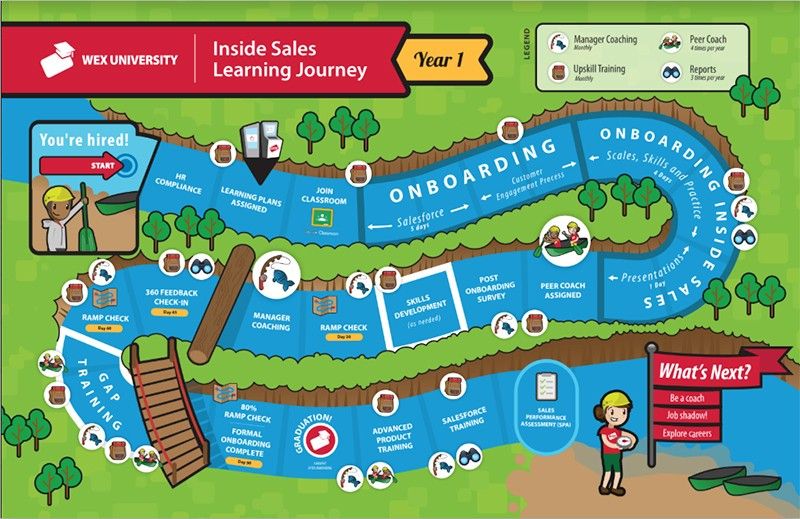
WEX Inside Sales Learning Map
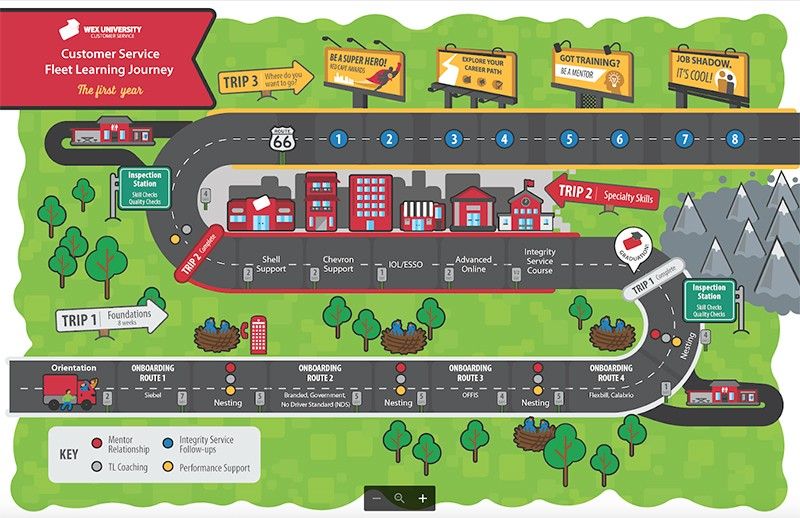
WEX Customer Service Learning Map
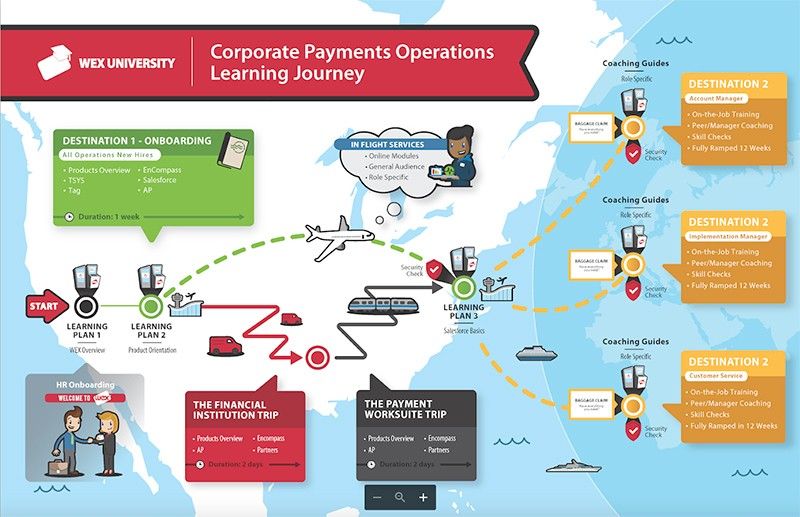
WEX Operations Learning Map
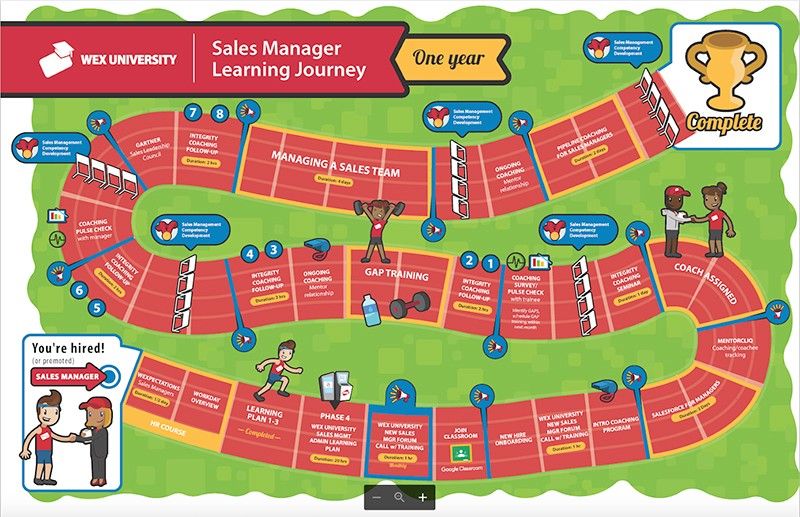
WEX Sales Manager Learning Map
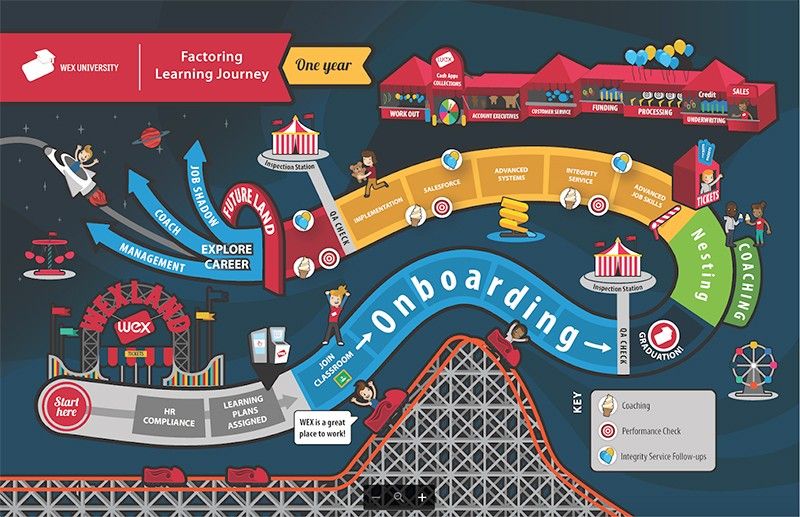
WEX Factoring Learning Map
If your company’s operations include hiring and training a remote contact center team, consider the tips we’ve outlined above. In the throes of this pandemic, there is much we can learn from one another. WEX’s Kathryn Connolly exemplifies this with generosity and grace by sharing the many lessons she’s learned while steering WEX’s contact center toward remote workforce success.
To learn more about WEX, a growing global organization, please visit wexinc.com.
Resources:
Workforce Management Today
Harvard Business Review
Global Workplace Analytics
Subscribe to our Inside WEX blog and follow us on social media for the insider view on everything WEX, from payments innovation to what it means to be a WEXer.